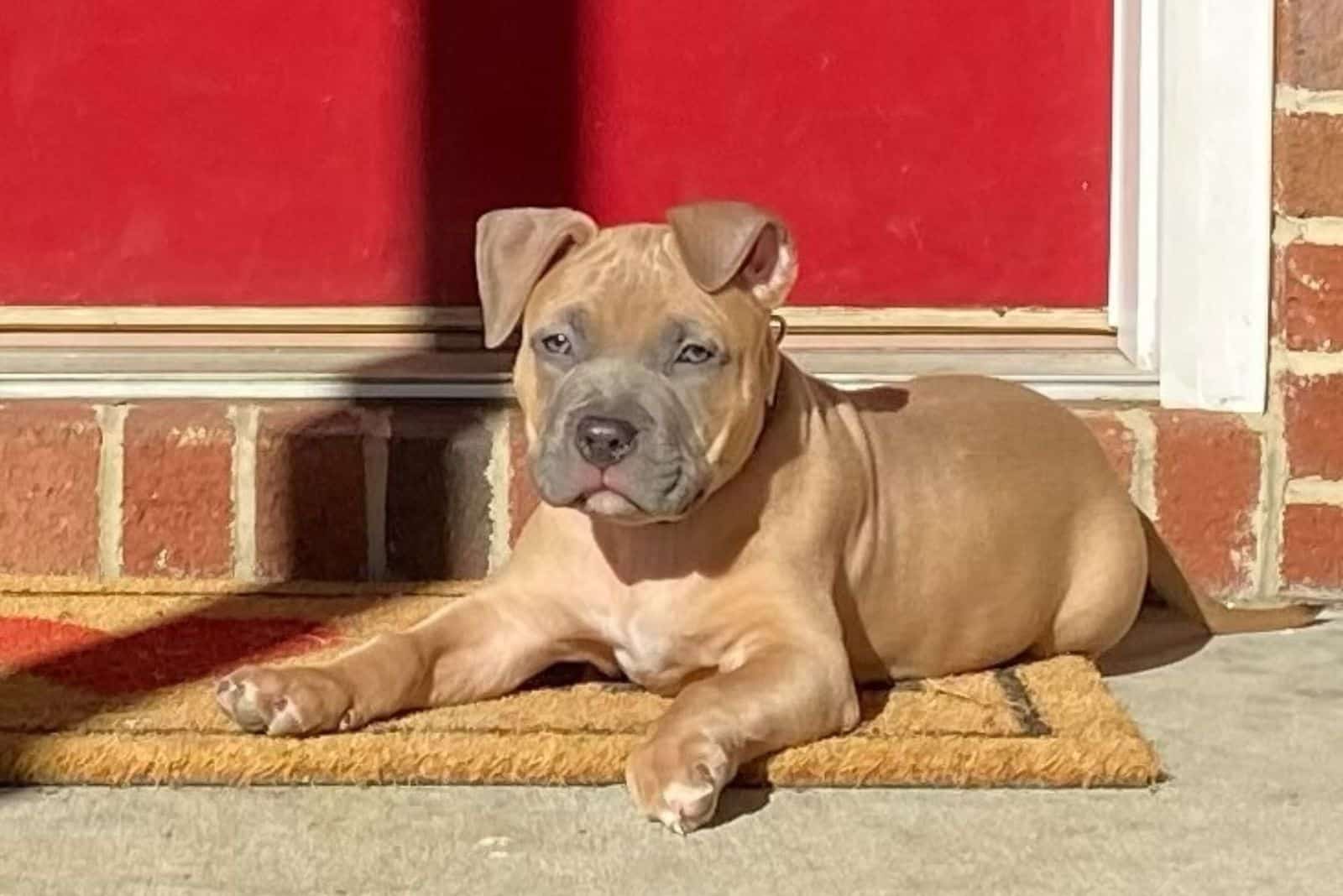While American Bullies themselves are initially designed by mixing an American Staffordshire Terrier, an American Pitbull Terrier, and some Bulldog breeds, their offspring – the Pitbull Bully mix, is more of a terrier-like dog that has the dominant bloodline of a standard Pitbull.
These hybrid dogs are not that uncommon to come across as you can find them all over the United States. Unfortunately, the breed faces many prejudices as bully breeds are often perceived as aggressive, hazardous, and unreliable.
However, the Bullypit puppy is far from being all that as this breed makes a wonderful family companion and a great nanny, too! But, let’s give this puppy a proper introduction first!
Note: The Pitbull Bulldog mix is also referred to as the Bullypit.
What Is The Pitbull Bully Mix?
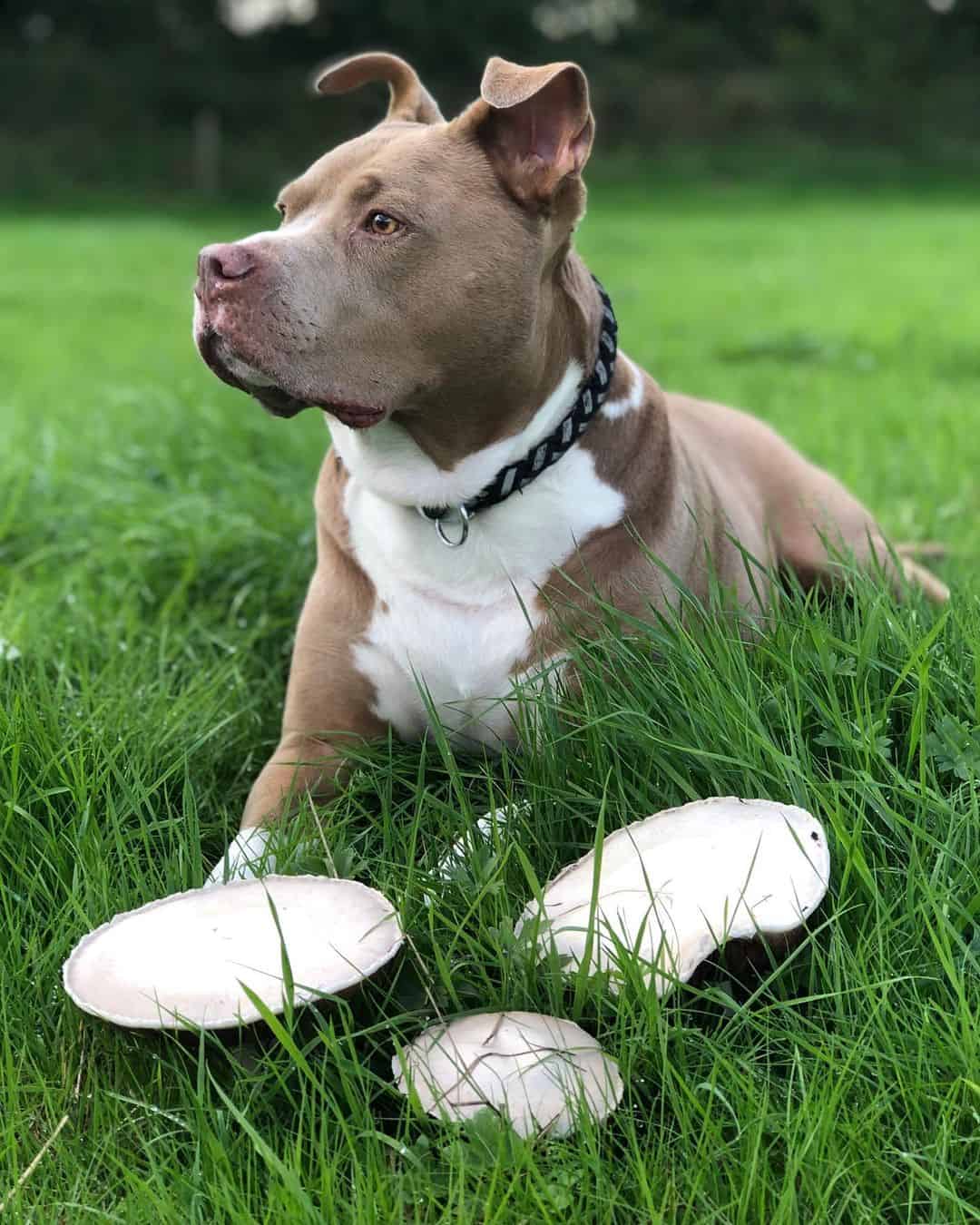
The Pitbull Bully mix represents a crossbreed between an American Bully dog and a Pitbull. While many people mistake American Bullies with American Pitbull Terriers, the truth is that these are two completely different breeds.
While dog registries, such as the American Canine Hybrid Club and the International Designer Canine Registry recognize Bullypits that are crossbred between an American Bulldog and a Pitbull, Pitbull Bully mixes are slightly less represented among breeders.
Even though Bullies are, by default, extended Pitbulls that also happen to have the Bulldog’s DNA, this breed was officially recognized as independent in 2013 by the United Kennel Club. However, American Bullies are not recognized by the American Kennel Club.
On the other hand, the term ‘‘Pitbull’’ refers to several breeds: the American Pit Bull Terrier, the American Staffordshire Terrier, and (so far) the American Bully.
However, Pitbulls themselves have a dominant terrier gene in their bloodline, which distinguishes them from their Bully counterparts.
Another difference between these two breeds is their origin. Pitbulls are much older dogs that initially came from the United Kingdom. The breed dates back to the 1800s, when it was used as a bull baiting dog and a fighting dog.
On the other hand, Bullies were originally designed in the United States in the 1980s by mixing the American Pit Bull Terrier and several Bulldog breeds.
Nowadays, reliable American Bully breeders sell these puppies as companion dogs, as Bullies are known to be exquisite family pets that display affection, loyalty, and playfulness as their main traits.
Parent Breeds
In order to understand the character of a Pitbull Bully mix, we need to dig into its parent breeds’ character first.
Both American Bullies and Pitbulls make dominant, strong, and confident dogs that were initially bred for dogfighting and bull baiting. However, both of these breeds are nowadays popular family dogs that fit perfectly into all types of families.
In fact, their offspring – the Bullypit – makes a fantastic mixed breed dog that has a great relationship with small children and other pets.
Since both Pitbulls and Bullies are the result of initial crossbreeding between Terriers and Bulldogs, a future owner needs to be careful when choosing a reputable breeder.
Many unreliable backyard breeders sell their Pitbull mixes as full-blooded canines, and the same goes for the American Bully.
American Bully
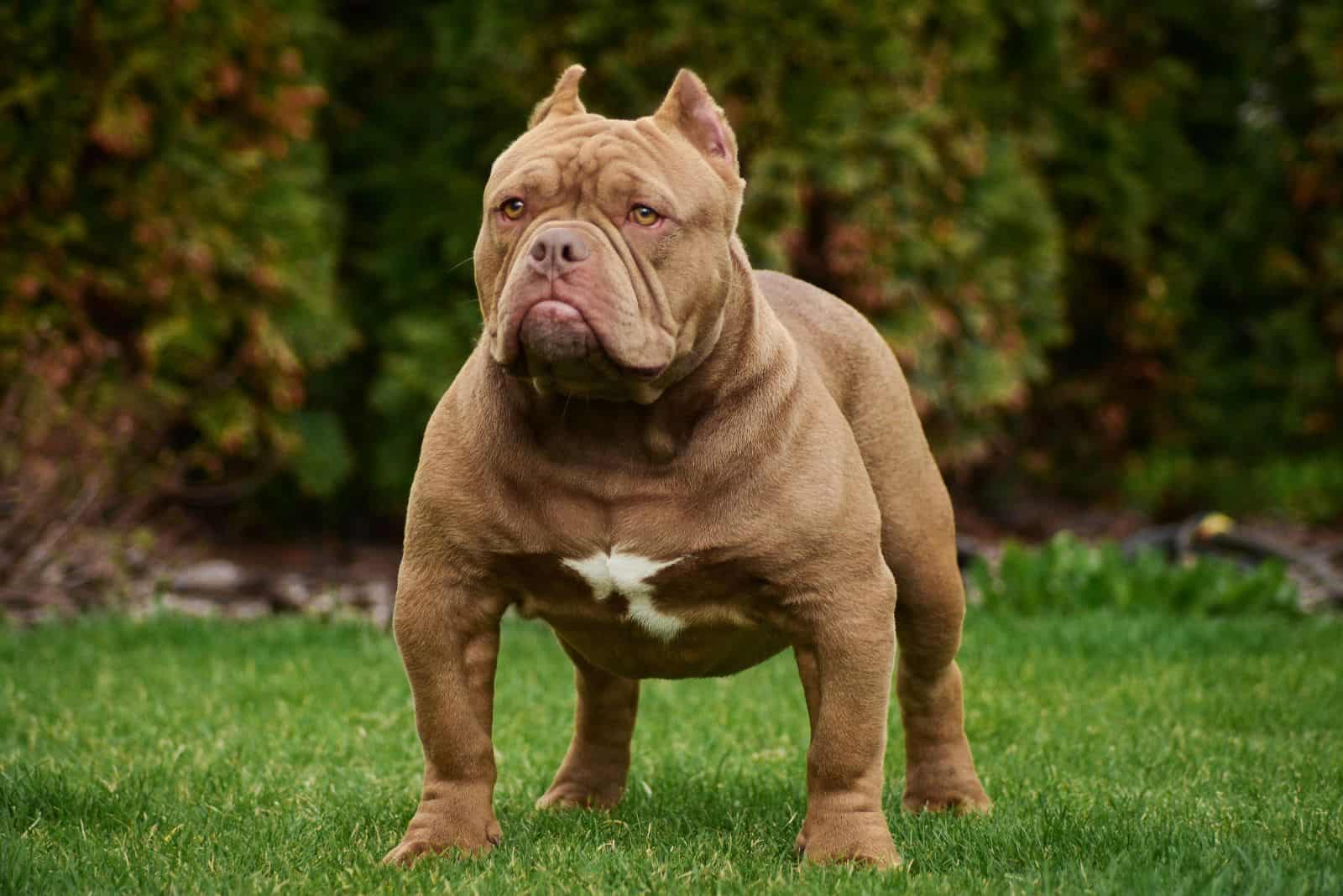
Many inexperienced dog owners mistake Bullies with American Bulldogs. Even though these two breeds share a plethora of common traits, the truth is American Bulldogs are far more different. Namely, American Bulldogs come from a lineage of Johnson Bulldogs and Scott Bulldogs.
John D. Johnson, the veteran from WWII, has credit for re-establishing this breed, which was almost extinct during the 20th century. Unlike Bulldogs, American Bullies are slightly smaller, but more muscular dogs.
Their stocky, medium-sized body makes them appear intimidating and less athletic than other terrier breeds, such as Pitbulls and Boxers. The breed is 13 to 21 inches tall, while its average weight revolves between 70 and 110 pounds.
Even though they are not considered as purebred dogs by the AKC, these doggies were officially recognized by the UKC in 2013 as an independent breed. These canines prefer a warmer climate as they do not do well in cold weather.
They have a short, smooth coat that is easy to groom. Weekly brushing is usually enough to keep their coat neat. Instead of frequent baths, you can always use a washcloth dipped in water to clean their coat.
Bullies are extremely good pets that adapt easily to all kinds of home environments. However, these canines need early socialization and firm leadership to avoid unpleasant outbursts.
Despite the fact that these canines seek a pack leader in their owner, they don’t respond well to yelling. The use of positive reinforcement techniques is highly encouraged for a Bully dog.
Healthy snacks, Bully dog toys, praising, and petting are just some of the things that you can apply. Bully dogs are highly interested in treasure hunts, hide and seek, and chase.
Unlike other terrier mixes, these dogs are not the best guard dogs, but their intimidating looks make them solid watchdogs.
Pitbull
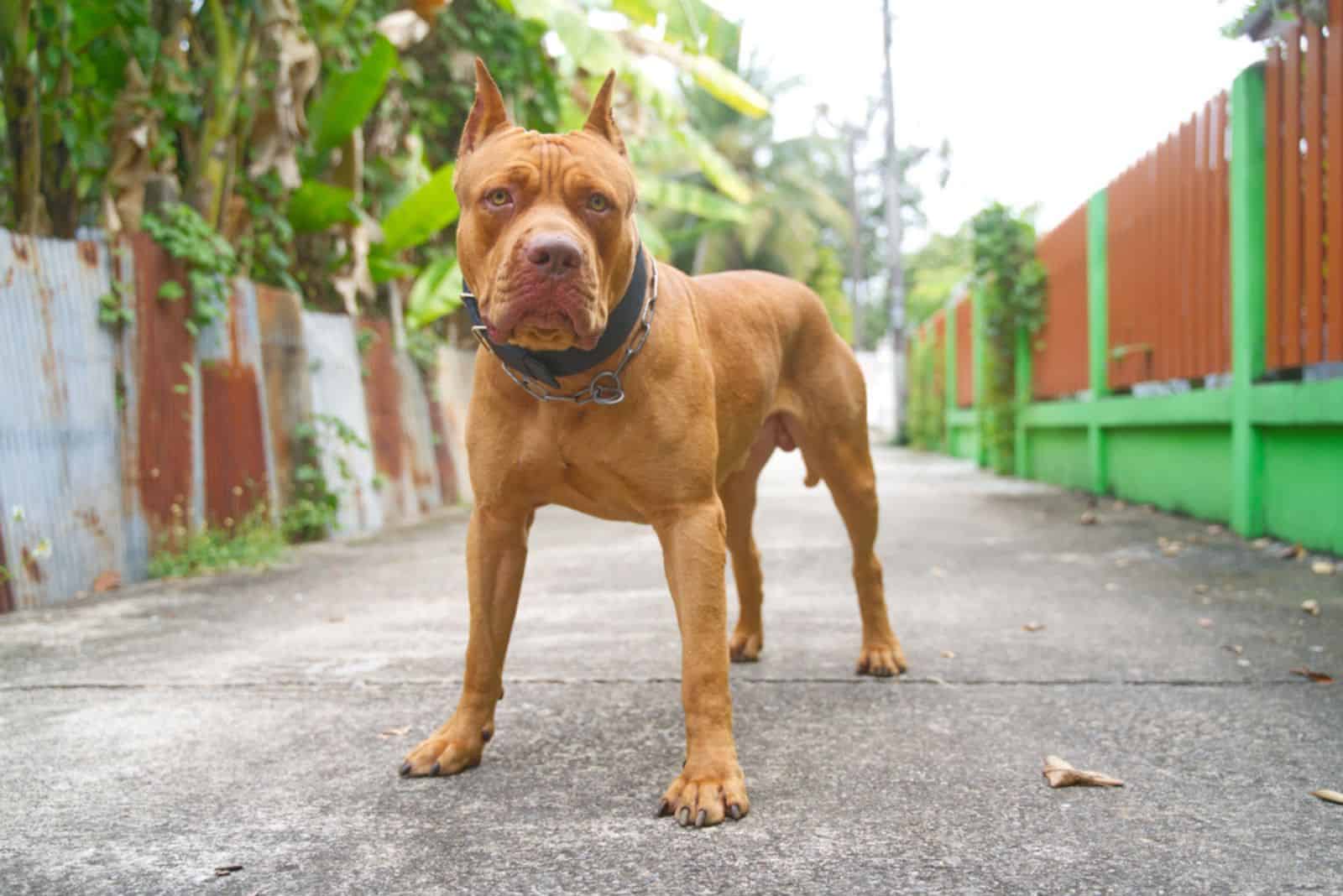
Originally coming from an Old English Bulldog and a Terrier, Pitbulls date back to the 1800s. Unlike their Bully counterparts, these dogs have more terrier traits in their bloodline, which makes them far better watchdogs.
The American Kennel Club doesn’t recognize a Pitbull as an independent dog breed. The only Pitbull breed recognized by the AKC is the American Staffordshire Terrier.
These terrier canines are dogs of agility, high physical activity, and exquisite strength. Unfortunately, they are often misperceived as violent and aggressive due to their history of being initially bred for blood sports, such as bull baiting and dog fighting.
The breed stands up to 21 inches in height. On the other hand, the breed’s weight revolves between 35 and 60 pounds, which makes them far smaller than their Bully counterparts. This is a medium-sized dog that is nowadays bred for family purposes exclusively.
These canines have a short, smooth coat that sheds moderately. While most Pitbulls come in black, blue, fawn, brindle, white, tan, and gray coat color patterns, with a black or blue muzzle, red-nose Pitbulls are also highly favorable among dog owners.
As some Pit puppies have a skin problem, it is required to maintain their cleanness with high-quality dog shampoos. Other health problems related to this breed are hip dysplasia, kneecap dislocation, and heart disease.
Pit canines are extremely affectionate, loyal, and confident dogs. While many perceive them as violent and aggressive, the truth is that this is a decent family dog that doesn’t display bad behavior by default.
The Crossbreed’s History
It is less known what the exact origin of a Pitbull Bully mix is. However, it is believed that breeders wanted to design a Bully dog with the greater set of traits of a Pitbull puppy.
That said, Bullypits are more likely to be terrier dogs than bully dogs. Unlike American Bulldog Pitbull mixes, these canines are generally smaller, far more agile, and athletic.
Given their origin, Pitbull canines qualify among the strongest breeds in the world. However, the breed is not as big as some other Bully breeds, which adds to their athletic look and great stamina.
Even though these canines originally came into existence by crossbreeding an English Bulldog with a Terrier breed, Pitbulls are nowadays mostly terrier dogs that enjoy the status of decent watchdogs and reliable family pets.
On the other hand, their American Bully counterparts, despite being extended Pitbulls, make a separate breed that is known for their loyalty, companionship, and affection.
However, Bully puppies may be too much for novice owners as they are hardly motivated and enthusiastic when it comes to training.
Physical Appearance Of The Pitbull Bully Mix
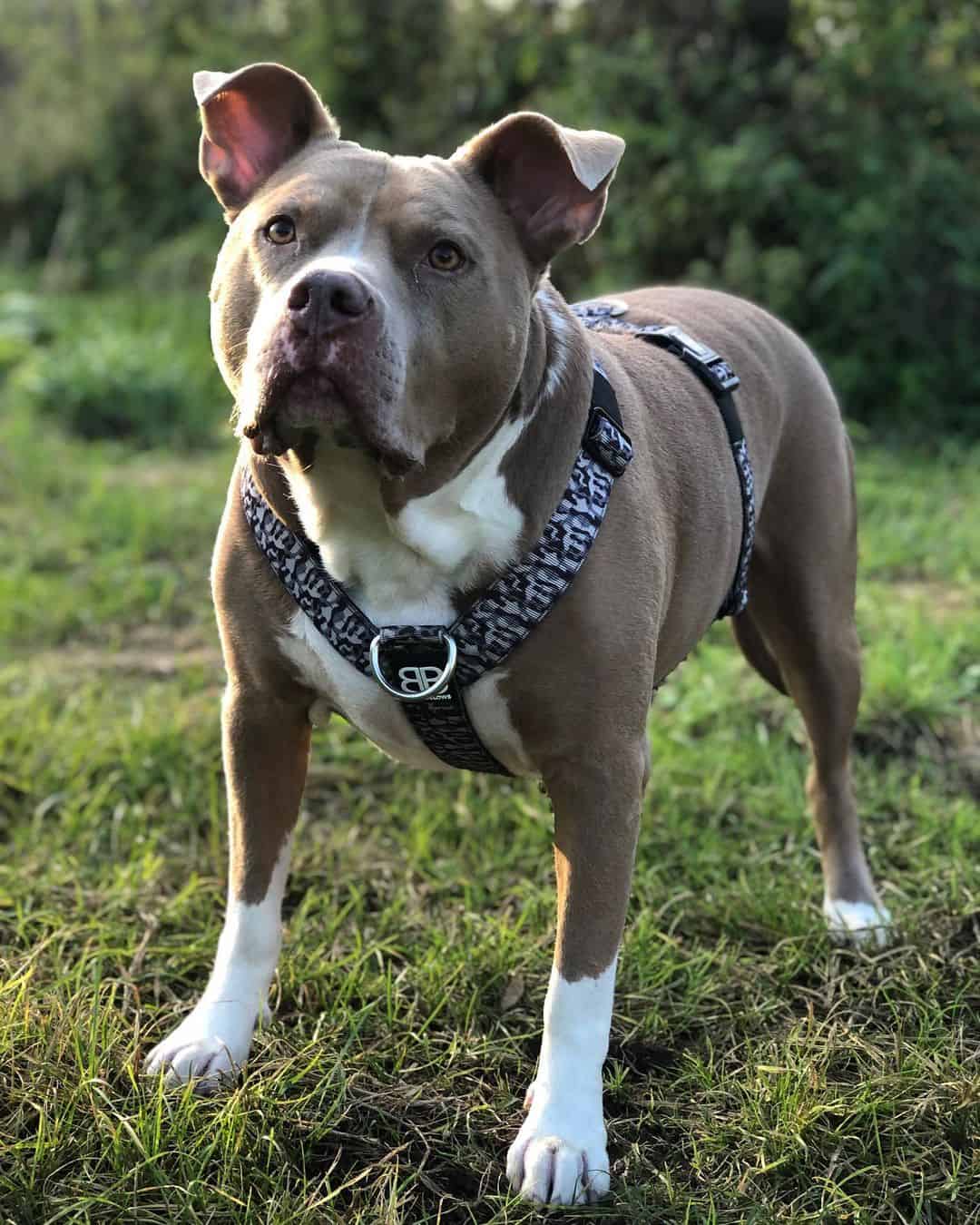
Unlike some other Pitbull mixes, such as the Rottweiler Pitbull mix, these hybrid dogs are most likely to have shorter legs and a stockier body. That said, Pitbull Bully mixes are generally smaller than their Pit parents.
Furthermore, the breed has a muscular body with a heart-shaped head. Their mouth appears to unlock a beautiful smile when open. These canines have a shorter nose than Pit puppies, which is one of the reasons why they may be affected with heat stroke.
Even though the breed is generally bigger than their Pit parents (and consequently less agile), these canines have high exercise needs.
They’re not Retrievers, or GSDs, but these canines need a solid, one- to two-hour exercise during the day. Bullypits at a young age require an even higher-intensity training.
Size
Pitbull Bully mixes are up to 21 inches tall. Their average weight revolves between 50 and 100 pounds, which makes them medium to large dogs. Just like their Bully parents, these canines are also prone to excessive weight gain.
Choosing the best dog food for a Bully dog is a must as these canines are easily overfed. The same goes to their offspring – the Pitbull Bully mix.
Obesity in these canines directly leads to a plethora of health conditions such as diabetes, cataracts, heart failure, and bone fractures.
That said, you should research the breed info deeply before buying this dog for yourself. They require proper maintenance, timely feeding, and a well-established feeding chart.
Due to their bigger size, these types of dogs are not ideal house dogs as they need a spacious environment and a big back yard. Still, early-trained Pit Bullies will be decent family dogs that know how to behave inside a house.
Coat Type
Generally, these designer dogs have a short, smooth coat that is easily maintained. They need regular, weekly brushing to remain neat and shiny. On the other hand, these doggies don’t require as frequent of baths as some other breeds.
An occasional, quarterly bath will be more than enough to keep your dog clean.
However, you should take into consideration that these canines are prone to skin problems such as infections, dermatitis, and dry skin. Rather than choosing the best smelling dog shampoos – choose the one that has the least invasive effect on your Pit Bully.
If you notice symptoms such as inflammation, redness, rashes, flaky skin, swelling, or a lump – visit your vet as soon as possible. Skin diseases are generally not fatal, but they are highly unpleasant, and they can cause major inconvenience for your pet.
Furthermore, you should know that this is not a non-shedding, hypoallergenic dog. These canines occasionally leave their hair trails all over the house, which is why you should consider having another breed if you, or some of your family members, suffer from dog allergies.
Coat Color
As there is no clear rule on what color these dogs should be, you can expect a Pitbull Bully mix to appear in both Pit and American Bully colors. That said, these canines appear in fawn, brindle, tricolor, white, black, red, gray, tan, and brown color variants.
Despite the fact that they appear intimidating at first, their wonderful color variations and neat, shiny coat make these canines truly fashionable.
Still, if you want your Pit Bully to look as sharp as possible, you might want to regularly groom it. That said, you should brush them once or twice on a weekly basis.
Puppies that go out on a regular basis will need more frequent bathing than puppies that stay at home.
When it comes to their eye color chart – these canines might have blue, hazel, or brown eyes.
The Pitbull Bully Mix’s Temperament
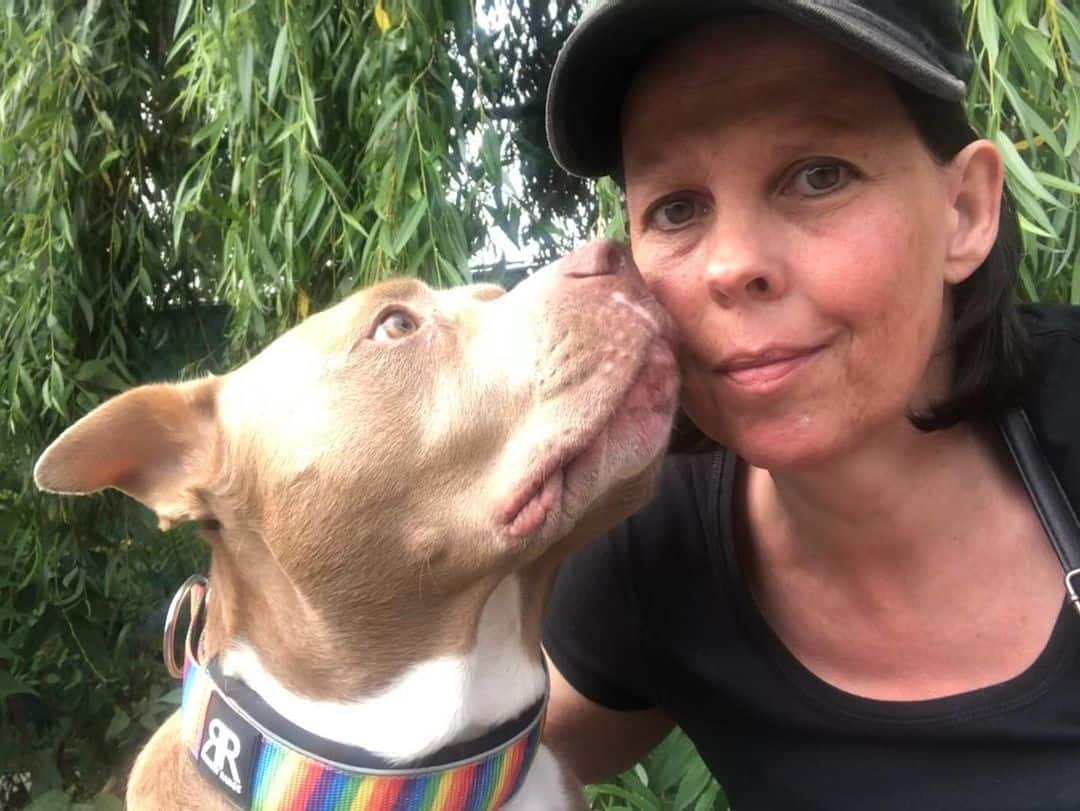
Even though the Pitbull Bully breed appears as an intimidating, aggressive, and violent dog, the truth is that these canines are true sweethearts.
They make reliable, friendly, muscular dogs that seek attention and love from their owner. Reciprocally, Pit Bullies give back to their owner affection and loyalty.
They are generally good with all family members, including small children. Some Pit Bullies are even known to be excellent nannies.
Generally, these pooches love accompanying their owner, even though they are not the most enthusiastic dogs in the world. They require a creative owner who knows how to mentally stimulate them. Otherwise, these puppies can become bored and lazy.
Laziness, though, is never a good option in a Pit Bully. Inactive dogs are far more liable to gain weight, which positively correlates with many health issues, such as diabetes and heart disease.
Mental stimulation is crucial both for their physical and mental health. Furthermore, Pit Bully canines require early socialization training. Otherwise, they can be wary of strangers, and display occasional aggression.
The recommendation is to invite as many friends as possible to your house during the early puppyhood stage of your Pit Bully. That way, your dog will better learn how to distinguish friends from enemies.
Furthermore, obedience training is highly recommended as puppies that are obedience-trained are generally easier trained and better behaved.
Are Bullypits Good Family Dogs
Even though this is not the ideal family dog (due to its large size), Pit Bullies can be decent family dogs when trained.
Naturally, these pooches require a spacious home and a big back yard where they can move freely. However, early-trained puppies will be perfectly able to fit into any sort of environment.
Obedience training and socialization are a must if you’re planning to keep your Pit Bully next to small children or other pets. Even though they are not naturally as aggressive as Rottweilers, GSDs, and Dobermans – these pooches are often unaware of their size and strength.
That said, they may play roughly with children at times and cause injury. Furthermore, an owner should encourage them to be aggressive as they may pick up that sort of behavior as their base.
You should rather stimulate them with positive reinforcement techniques, such as interactive dog toys or healthy snacks. However, you should wisely manage their snack time as these giants are voracious eaters that will easily trick you into giving them more than enough.
Pit Bullies are generally protective towards their family, which is why they make decent watchdogs. However, this is not the best family guardian as Pit Bullies don’t display natural aggression towards strangers, like Rottweilers, GSDs, or Dobermans do.
When To Socialize A Bullypit
It is always better to socialize your Bullypit at an early age as socializing an aggressive dog in its adulthood is far more complex.
That being said, you should start the socialization process at eight to ten weeks of age, which is when puppies are usually picked up from breeders.
In that regard, you should always consider buying a Bullypit from the most reputable breeders on the market. Puppies purchased from high-quality breeders are already potty trained and familiar with some basic commands.
If, by chance, you happen to buy or adopt an adult Bullypit that is not properly socialized, you should take things slowly. Unfortunately, these canines are not the fastest-learning dogs in the world, which means that they will need a lot of patience and commitment.
In particular, you should never force your Bully Pit to do what they are not capable of. These canines are not as intelligent as Poodles or GSDs, which is why they may not find themselves enjoying exhaustive mental games that much.
Worse, you should never yell, punch, or scream during training. These pooches don’t respond well to harsh behavior, which is why you can expect them to fight back!
Trainability
Breeders describe this dog as average or above average in terms of intelligence. With that being said, Pit Bullies are relatively easy to train, although they are not the easiest dogs to potty train or to obedience train.
They may display occasional stubbornness or lack of enthusiasm. That’s why you should always come up with creative ways to motivate your dog. Positive reinforcement techniques are great in that regard as these canines respond well to praisingand petting.
Generally, you won’t have a problem teaching your Bullypit basic socialization. These canines are naturally loyal, affectionate, and friendly towards both their owner and strangers.
However, you should focus more on teaching them how to play gently with small children and smaller pets.
They are usually unaware of their power, which is why they may unintentionally hurt children and small pets during playtime. However, properly-trained Bully Pits will be decent and gentle.
In fact, puppies trained in big families with small children will develop a great parental instinct. In that regard, Bully Pits can make excellent nannies.
There are some outdoor activities that your Pit Bully will never say no to. Games, such as chasing, treasure hunt, and hide-and-seek are perfect ways to both mentally stimulate your dog and provide a proper amount of daily exercise.
Aggression
Due to their violent history, both of the Bullypit parents qualify among aggressive dog breeds. However, none of these dogs, including their offspring, will ever display aggression unless highly necessary.
In particular, there are several scenarios in which your Pit Bully can be aggressive. First, improperly-trained canines can display undesirable behavior, especially towards strangers or other animals. That’s why this breed is not recommended for first-time dog owners.
Furthermore, dogs trained for dogfighting are never reliable or good family dogs. However, the chances of adopting a dog trained for this bloody sport are relatively low as dogfighting is illegal in most states.
Pit Bullies tend to be aggressive during self-defense. Even though this is not the best guardian dog in the world, these canines may use their exquisite strength and power as a self-protection tool to defend themselves from predators or enemies.
Lastly, you can expect your puppy to display occasional aggressiveness or self-destruction as a result of severe separation anxiety. These hybrids don’t do well on their own, which is why you shouldn’t get them unless you have a highly-flexible schedule.
Pitbull Bully Mix: Health Issues
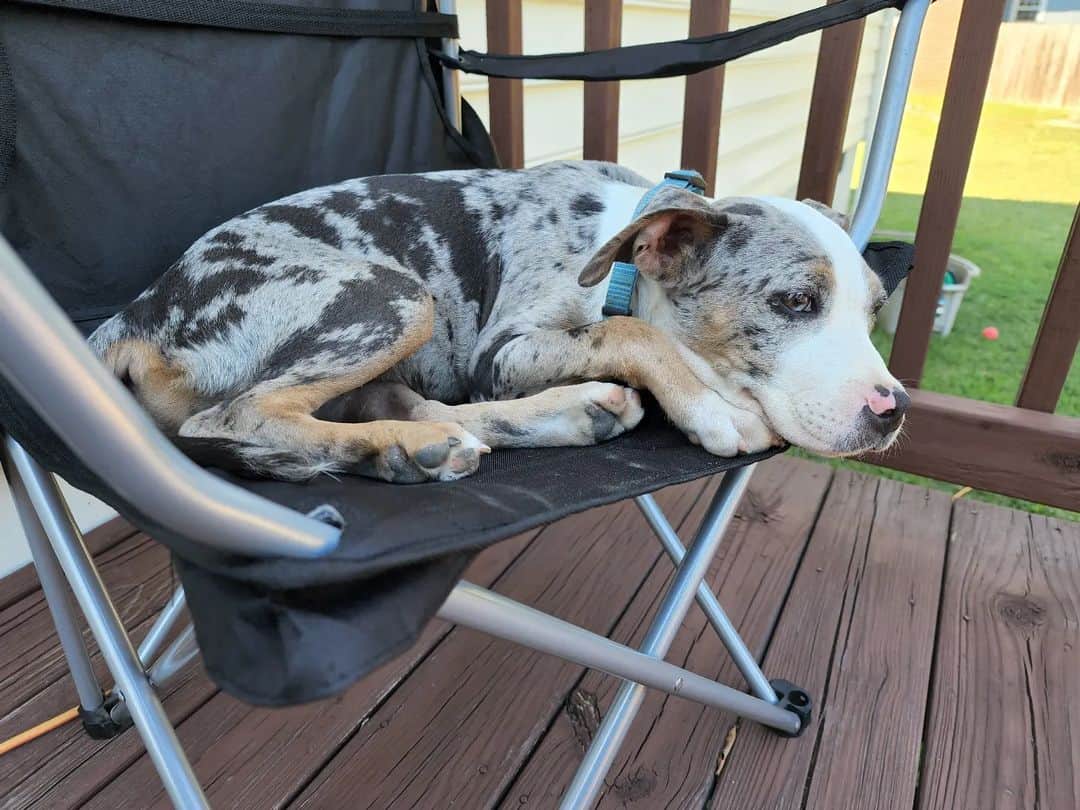
Generally, bully breeds don’t qualify among the healthiest dogs in the world. That said, these pooches face many health issues such as hip dysplasia, stomach torsion, heart disease, and allergies.
Still, the lifespan of these canines is quite respectable as they can easily reach up to 14 years of age. However, these canines need proper maintenance and a responsible owner to get there.
There are three things that you should pay attention to: dieting, timely healthcare, and a proper amount of exercise.
Dieting is an important part of every Pit Bully dog. Namely, these pooches don’t do well on junk food, which is why you should never feed your dog with your table scraps.
Furthermore, subjecting your dog to regular health exams (once a year for a healthy dog) is key. That way, you will be able to act timely in case your dog faces a progressive disease, such as cancer, cataracts, or heart disease.
Lastly, exercising a Bullypit puppy is as equally important as proper nutrition. Puppies that receive a proper amount of daily exercise are less likely to have heart problems in the future.
Hip Dysplasia
Canine hip dysplasia is a common condition for large dogs.
This particular condition represents the abnormality of a hip joint, which is manifested in a bunny walk, reluctance to jump, climb stairs or run, lethargic behavior, inability to perform regular puppy activities, and severe pain in the groin.
Even though hip dysplasia is not a fatal condition, it can be extremely unpleasant and painful. Recognizing the first symptoms of dysplasia will prevent a possible injury in the future.
Canines with hip dysplasia should not be overwhelmed with exercise, and their weight should be monitored at all times. Namely, weight gain can have a negative impact on puppies with this condition in terms of injuries and lack of movement.
Hip dysplasia in dogs is a hereditary disease, which means that you cannot do anything to prevent it. However, the advice is to preventively research the best possible Pit Bully breeders on the market.
Reliable breeders almost exclusively subject their newborn Pit Bullies to hip and elbow evaluation, which is why it is highly unlikely to pick up a puppy with hip dysplasia.
This condition is treated surgically most of the time. However, you should know that the average cost of hip dysplasia surgery revolves between $1500 and $3000, which is quite expensive.
Stomach Torsion
Stomach torsion, popularly known as bloat, is a condition developed as a result of improper feeding, eating junk food, and swallowing too much food at once.
Bloat in dogs is a serious condition that can have deadly repercussions. That’s why it is highly important to recognize the first symptoms of bloat, which include restlessness, a swollen stomach, stomachache, panting and breathing heavily, lethargic behavior, and lack of appetite.
If you notice that your dog refuses to drink water during bloat – that may be a red flag that requires immediate vet intervention.
There are some home remedies that you can do to prevent bloat in your dog. For starters, you should avoid giving your pet large meals. Rather, give them two to three smaller meals that contain healthy fats, protein, and green fibers.
Furthermore, you should avoid giving your dog late meals. Unprocessed food is as equally harmful as junk food.
Lastly, there is some research that indicates how dogs that eat from elevated feeding bowls are less likely to develop bloat. Namely, the position of your dog’s head during mealtime positively correlates with bloat occurrence.
However, there is no clear evidence that bloat is directly caused by improper positioning.
Heart Disease
Heart disease is quite common in all bully breeds. That said, Pitbull bully mixes are not a separate case in this regard.
The key to heart disease prevention is recognizing the first symptoms, which generally include lack of energy, lethargy, fainting, coughing, collapse, breathing difficulties, a swollen stomach, and lack of appetite.
In order to prevent heart disease in a dog, you should stay away from poor-quality dog food brands, as well as junk food. On the contrary, these canines require a well-planned meal plan and healthy foods.
Furthermore, puppies that exercise on a regular basis are generally less prone to heart disease of any kind. That said, you should subject your Pit Bully to one to two hours of exercise from early puppyhood.
Otherwise, you are risking having a dog with heart disease in the long run. Puppies diagnosed with congestive heart failure are most likely to live between six months and one year.
Allergies
The most common type of allergy in a Bullypit is skin allergy. These canines, although being neat and shiny, are prone to frequent skin problems, such as dermatitis.
Some Pit Bullies can be allergic to pollen, dust, grass, or mold. Subjecting a puppy to an early allergy test can prevent your dog from being affected in the latter stages of life. Knowing what sort of environment is hostile to your dog is the key to avoiding allergies.
On the other hand, you should carefully choose a dog shampoo for your dog as some shampoos contain ingredients that may trigger an allergy in your Pit Bully.
Other than that, these canines naturally have sensitive skin, which is why you shouldn’t bathe them as frequently as some other dog breeds. Excessive bathing can cause dry skin and dander, and remove natural oils from your dog’s coat.
Indeed, Pit Bullies are not a hypoallergenic dog breed, but that doesn’t necessarily mean that you should bath them on a weekly or a monthly basis. An occasional, quarterly bath will be more than enough.
The Pitbull Bully Mix: Price
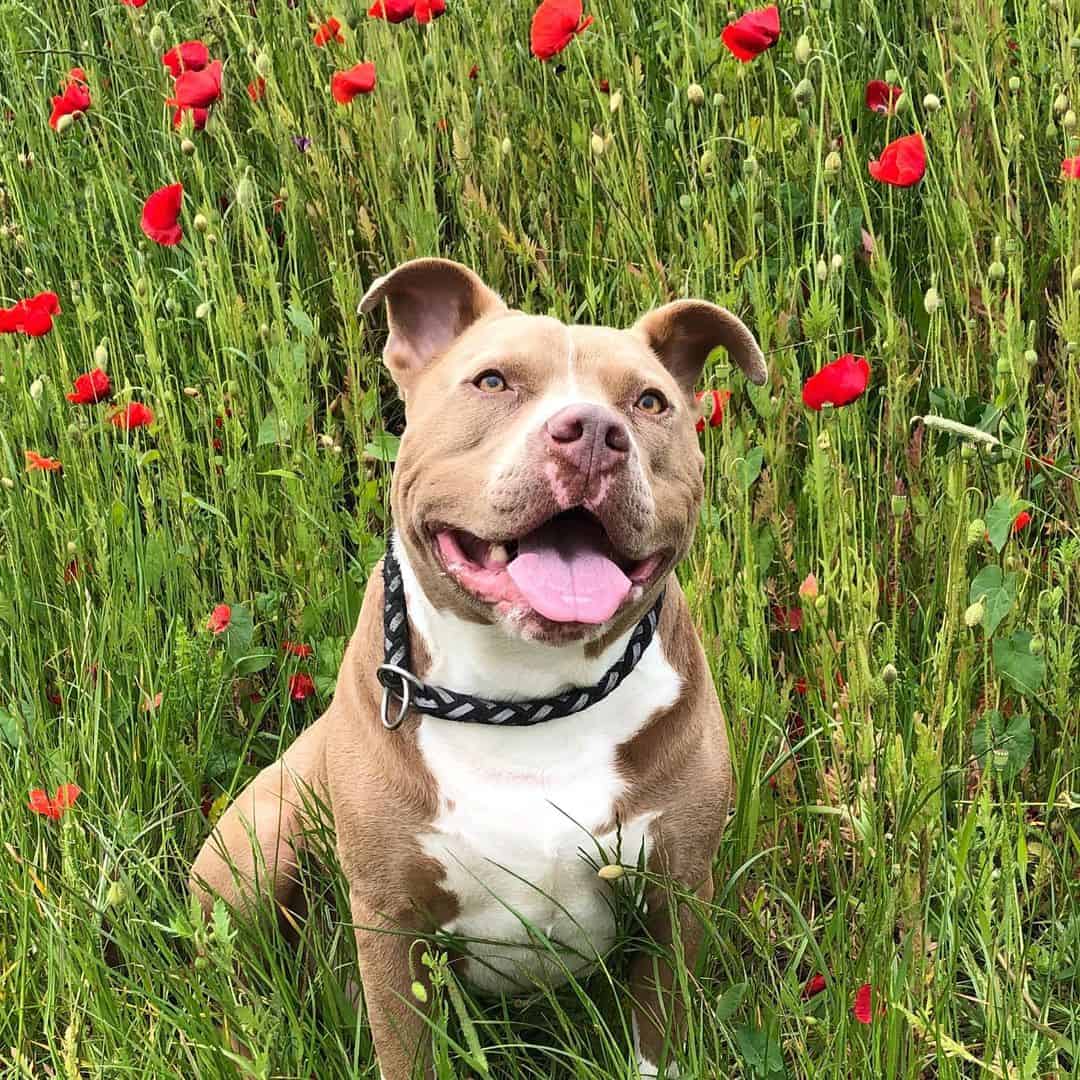
The price of these hybrid canines is not as cheap as you might think. Generally, these canines are sold at $2000 to $5000 on average. The reason why puppies are above average in terms of the prize lies in the fact that their Bully parents are extremely expensive.
The price of the American Bully dog can be anywhere between $2000 and $10000. On the other hand, Pit canines cost between $500 and $5000.
The reason for such a discrepancy in the price lies in the quality of the breeder. Particularly, the best Pit Bully breeders will sell their puppies at a significantly higher price, while you can find a cheap dog in an unreliable puppy mill or at a backyard breeder.
The advice is to always buy a dog from a reputable breeder. That way, you will save a ton of money in the long run.
Their price generally includes early health examination, DNA tests, vaccination, deworming, vet documentation, a microchip, the first pack of food, dog toys, and a blanket.
Additional Costs
Aside from the initial price and the first pack of food, there are other things that you should take into consideration when buying a puppy. For starters, getting a dog bed, a feeding bowl, a collar and a leash, poop bags, and an appropriate potty are a must.
You can find perfectly suitable dog beds for $50 to $60. On the other hand, food and water bowls cost $10 to $15 on average. The price that you can expect to pay for poop bags and a litter box is $100.
There are some extra dog items that might come in handy. For instance, having a dog training collar for your Bullypit is not the worst training tool. Furthermore, pet insurance is a very useful administrative tool to have if you’re planning to buy the Bullypit.
Depending on the package, you can expect to pay anywhere between $20 and $100 for pet insurance.
Lastly, owners who love traveling with their pets outside the States will need to consider paying for a dog passport. Depending on the state, the price for a dog passport revolves anywhere between $100 and $1000.
FAQs
Due to their intimidating looks and violent history, Bully Pits are not exactly the most desirable family dogs in the world. However, these canines are naturally loyal, affectionate, and eager to please their owner.
With that being said, Bully Pits make decent family dogs that adapt easily to all sorts of environments.
Still, they will need proper socialization and, if possible, obedience training. Some Bully Pits are pretty unaware of their size, which is why their playtime with children or smaller pets should be supervised.
The average lifespan of these hybrids revolves between 12 and 14 years. However, you should take into consideration that this is not exactly the healthiest dog in the world. Bullypits face various health issues such as heart disease, bloat, and hip dysplasia.
Additionally, their Pit parents are prone to cataracts. That’s why the Pit’s feeding chart should be carefully designed, as well as the feeding chart of its offspring – the Bully Pit. Cataracts and obesity in dogs are positively correlated.
In fact, both cataracts and heart disease are directly triggered by diabetes.
Conclusion
The Pitbull Bully mix is a one-of-a-kind hybrid dog. These large, intimidating at first, but heart-melting giants are often misperceived and misrepresented.
However, the truth is that both Pits and Bullies make fantastic family dogs once they are socialized and properly trained. Their offspring, the Bullypit, has even better genetic predispositions to be the perfect companion.
That said, choosing a Pit Bully won’t be a mistake if you’re ready to devote yourself completely.
Read more: Akita Pitbull Mix – A Powerful Dog For Experienced Owners
